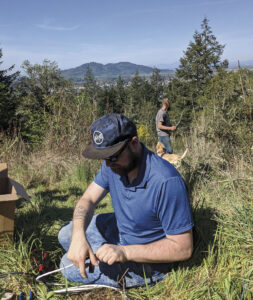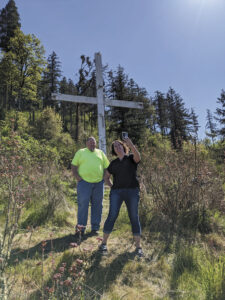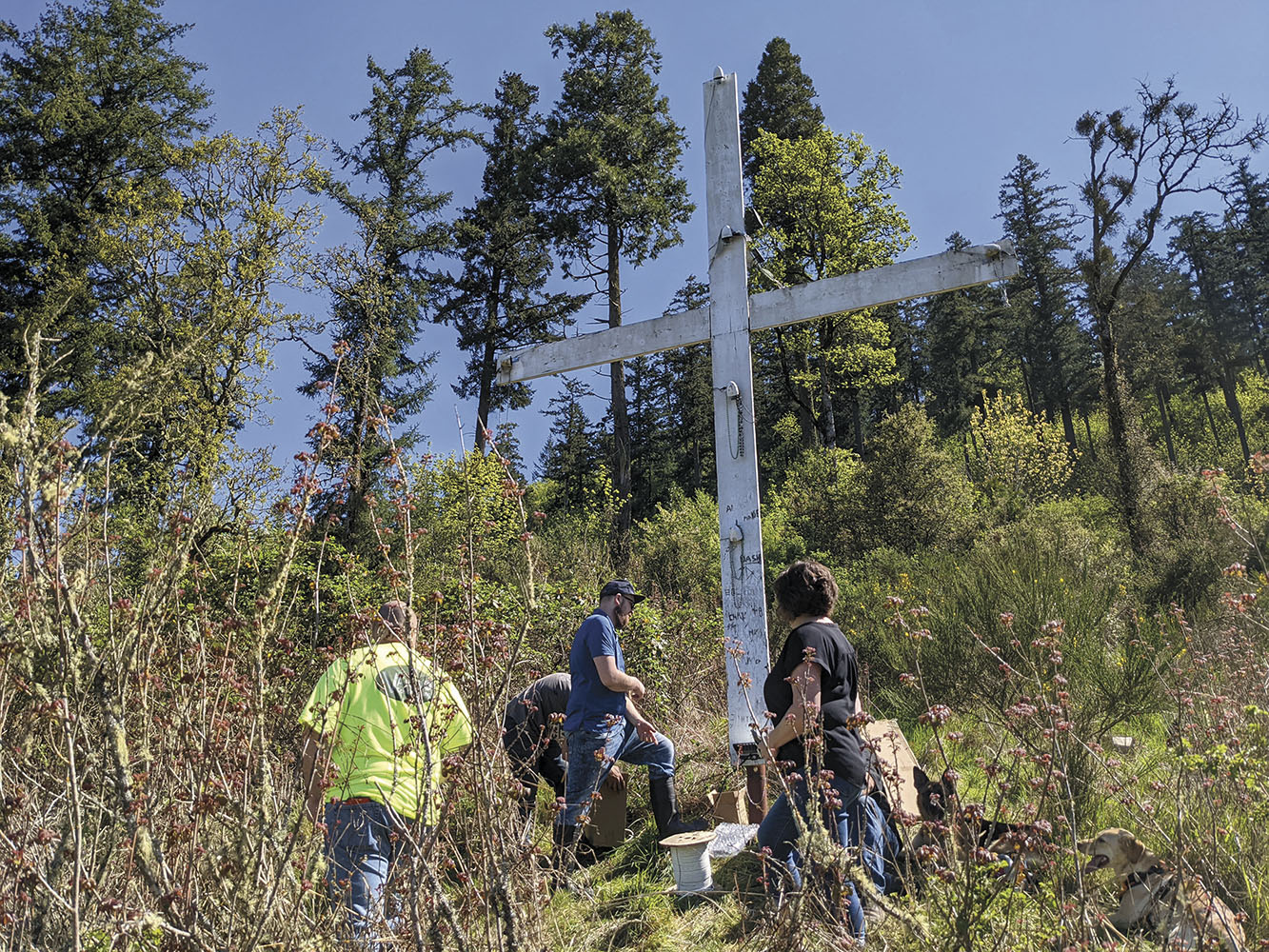By Sarah Brown
Lebanon Local
A light in the darkness, a tradition in Lebanon for some 65 years old but snuffed out some 28 years ago, was renewed once again when Nathan Reid and six others installed an LED lamp at the large cross on Ridgeway Butte April 20.
In 1955, a dozen men had built the large monument overlooking the city of Lebanon above Berlin Road, (known still to some as Horse Butte). Twice a year, lights surrounding the cross were turned on for the Easter and Christmas holidays.
And then, sometime in the late 1990s, the lights went dark. But the cross remained. The people of Lebanon – some old, some new – continued their lives below the butte.
But some remembered the cross. They fondly recalled looking up toward the cross and seeing the bright lights at night.
Some recalled hikes, camping trips, target practice and Easter sunrise services at the cross, along with one who said he buried his favorite dog up there.
The cross had always been maintained by the Junior Chamber of Commerce, also known as the Jaycees, until the 1990s when someone bought the property, said Tony Lindsey, a former Jaycee.
Lindsey was the last person to turn on the lights until the new property owner relieved him of the duty, he said. The property owner installed a small solar panel on the light, and that was the last Lindsey heard of the matter.

Reid, who doesn’t even live in Lebanon, heard stories about the cross and got inspired to re-ignite the tradition that symbolizes hope, peace and nostalgia for many.
He asked Mike and Becky Van Atta to help; it was easy for them to say yes.
“The community wants it, and I just feel like it’s going to show some beauty and light in the darkness. Who doesn’t love that?” Becky said.
Kyle Randleman, who joined the work party, said it’s important to him and to the community of faith to see the cross lit up again.
“It will shine at night, give some hope for the community, especially with what’s going on in our culture and the pandemic,” Randleman said.
That hope, he said, is that Lebanon can get through it all.
The cross has been standing on Ridgeway Butte for more than six decades, and remnants of the past still linger there.
Six mid-century lights are mounted on the post and cross arms, and hanging from them is a tattered pennant banner and several weathered bead necklaces.
They might be Catholic beads, Reid said.
Names and initials are crudely etched into the wood beams, marking past times when people trekked up the steep butte through poison oak.
The cross was the first big project undertaken by the newly-formed religious activities committee of the Jaycees in December 1955. It was spearheaded by Paul Gessford, who was about 30 years old at the time.
Morse Bros. gave the Jaycees permission to erect the cross, and the electricity was supplied by Consumers Power Co.
At the time, the Jaycees was a civic organization that instilled leadership skills, initiative and community responsibility for men in their 20s and 30s.

Their creed was “that faith in God gives meaning and purpose to human life; that the brotherhood of man transcends the sovereignty of nations; that economic justice can best be won by free men through free enterprise; that government should be of laws rather than of men; that earth’s great treasure lies in human personality; and that service to humanity is the best work of life.”
Jacob Barnhart, who doesn’t adhere to any one religion, but instead takes upon himself a mix of different spiritual beliefs, said one reason he was willing to help with the project was because “a good deed is a good deed.”
Rumors suggest the cross that overlooks the city of Lebanon today is not the original one. A 1960 news article briefly talks about a cross being built in 1952. Lindsey believes maybe that cross was destroyed in a storm. The current cross was described in a 1955 news story as a 30-foot-high, 20-foot-wide cross made of heavy timbers and sheathed in aluminum.
That first cross was fitted with 100 light bulbs, which were supposed to be visible as far away as Tangent.
When Reid heard residents reminiscing last year about the cross and lamenting that it was no longer lit up, he took the initiative to install a new solar light system.
In three days, a fundraising campaign raised $2,200, which was enough to purchase a better system than he originally planned, Reid said.
Permission from the current landowner was granted, so Reid ordered the system and waited.
The goal was to have the light installed in time for Easter this year, but unforeseen obstacles prevented the arrival and installation in time, he said. The light was installed just two and a half weeks past the Easter goal.
Whereas, in the past, the lights were turned on twice a year, now the cross will be lit year-round. It was a task the Jaycees were responsible for every year, but Reid thought it best to reduce the number of times anyone has to go up there for maintenance, he said.
He has, after all, been stricken with a bad case of poison oak both times he’s made the trip.
The new lighting system for the cross includes a battery backup, and uses just one bright LED lamp that shines upward toward the cross.
“The solar panel and the batteries and everything was the best we could possibly get for the budget,” Reid said.
Without light shining on the panels, the battery can power the lamp at full brightness for 24 to 48 hours, depending on the age of the battery, he said.
Since installation, Reid has been told by some that the new light can be seen, but the shape of the cross is not obvious. For that reason, more volunteers might be needed to return and alter how the cross is lit up.
Barnhart hopes the community will see the cross as a project that brought people of varying beliefs together to “do something for the community to bring inspiration and to show teamwork and good core building skills.”
He also noted the cross is a beacon of hope in a time of mistrust.
“Right now, everyone is looking for a way to kind of make sense of all the turmoil and all the pain that’s going on,” Barnhart said.
In 1959, a minister wrote a column in the newspaper about the symbolism of the cross. He said, “The cross shows that God is merciful, that though men, even men in the church, are beset by sin, God does not cast them off, but wills to help them be free, responsible and mature people.”
And in 1956, as the cross’ lights were being turned off post-Christmas, another columnist wrote, “It would be nice if that inspirational symbol of the better things in life could shine every night of the year.”
And now it does.





